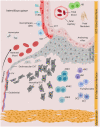Innate Immune Mechanisms to Protect Against Infection at the Human Decidual-Placental Interface
- PMID: 33013876
- PMCID: PMC7511589
- DOI: 10.3389/fimmu.2020.02070
Innate Immune Mechanisms to Protect Against Infection at the Human Decidual-Placental Interface
Abstract
During pregnancy, the placenta forms the anatomical barrier between the mother and developing fetus. Infectious agents can potentially breach the placental barrier resulting in pathogenic transmission from mother to fetus. Innate immune responses, orchestrated by maternal and fetal cells at the decidual-placental interface, are the first line of defense to avoid vertical transmission. Here, we outline the anatomy of the human placenta and uterine lining, the decidua, and discuss the potential capacity of pathogen pattern recognition and other host defense strategies present in the innate immune cells at the placental-decidual interface. We consider major congenital infections that access the placenta from hematogenous or decidual route. Finally, we highlight the challenges in studying human placental responses to pathogens and vertical transmission using current experimental models and identify gaps in knowledge that need to be addressed. We further propose novel experimental strategies to address such limitations.
Keywords: decidua; innate immunity; trophoblast; uterine-placental interface; vertical transmission.
Copyright © 2020 Hoo, Nakimuli and Vento-Tormo.
Figures




References
-
- Benirschke K, Kaufmann P, Baergen RN. Pathology of the Human Placenta. Berlin; Heidelberg: Springer; (2006).
Publication types
MeSH terms
Grants and funding
LinkOut - more resources
Full Text Sources

